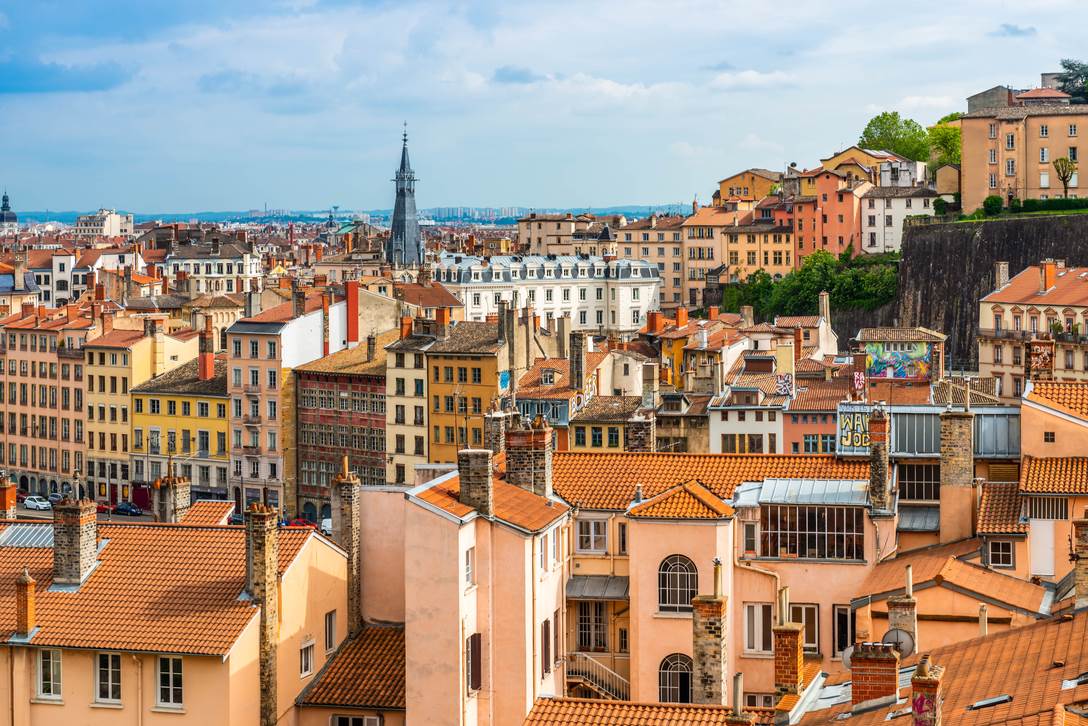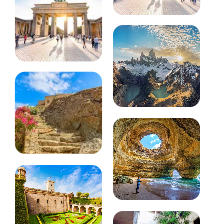Lyon’s Croix Rousse district: what to do and what to see

In the 19th century, you would have walked the streets of the Croix Rousse to the sound of the bistanclaques, the weaving looms whose name comes from the very particular noise they produced. The silk industry, which has been the lifeblood of this district for over 5 centuries, is still present, albeit on a smaller scale. The Maison des Canuts (the name given to the silk workers) is a must-see when you visit this legendary district. You’ll fall under the spell of the village spirit of this district, with its slopes, street art staircases, traboules, trompe l’oeil and its immense plateau offering a magnificent view of the Fourvière basilica, Old Lyon and its peninsula.
La croix Rousse, an artists’ quarter
The Parisians have Montmartre, the Lyonnais have the Croix Rousse! Art galleries, arts and crafts, designers, cafés, theatres and trompe l’oeil are all great ways to discover this facet of the Croix Rousse.
Street art, graffiti and graffiti art
Most of these are ephemeral works of art, although some are more permanent and can last for several years. The best known is the Canuts wall, which covers the entire facade of a building. The special feature of this fresco, apart from its size, is that the people depicted actually live in the Croix-Rousse district. Other points of interest:
- The Passage Mermet and its “blue staircase”,
- Davis Bowie’s vairon gaze on rue Neyret,
- The stairs in rue Prunelle…
The creators’ village
At the Passage Thiaffait, 75 fashion, interior and design artists present their creations all year round.
Place des terreaux
This square, built in the 17th century, is the political heart of the city of Lyon. It is also a cultural space that takes pride of place during the Festival of Lights. The people of Lyon love this square for its beauty, and for meeting up in one of the many restaurants, or on a terrace for a coffee. The Place des Terraux is reached by climbing the Grande Côte. Points of interest :
- The Town Hall, built in the 17th century and restored in the 19th century following the bombings.
- The Palais Saint-Pierre, this former abbey now houses the Musée des Beaux-arts. The decor of the refectory and the 17th-century Great Staircase are absolutely magnificent, as are the cloister and gardens.
- Bartholdi’s 19th-century fountain was originally created for the city of Bordeaux, which is why it represents the Garonne and its 4 tributaries.
Did you know that? It was from the balcony of the town hall in 1944 that General de Gaulle proclaimed Lyon to be the “capital of the Resistance”.
The traboules
How can you visit the Croix Rousse without passing through the famous traboules! Traboules are passageways between buildings that lead to parallel streets. This pedestrian passageway links courtyards and buildings together, and looks very much like a secret passageway…
The Court of the Voracious
This traboule owes its fame to the Canuts revolt in 1848, when it was used as a refuge. These silk workers, who lived in great poverty, had to hide from the soldiers in charge of putting down these workers’ revolts. During the 2nd World War, the Cour des Voraces was a secret passageway used to avoid German surveillance, and is an emblematic site on the slopes of the Croix-Rousse.
The monumental staircase covers 6 floors of the building and serves as a link between 3 distinct areas (Place Colbert, Montée de Saint-Sébastien and Rue Imbert-Colomés).
Other traboules
Traboule Imbert Colomès, traboule des Capucins, traboule de Thou and its magnificent staircase…
The Croix-Rousse plateau
From the large esplanade, you can see the Parc de la Tête d’Or.
Le Gros Caillou
This big rock attracts and intrigues passing tourists, and its story is quite original. When workmen were drilling the string that would link the centre of Lyon to the Croix Rousse via the funicular railway, they came across this huge block of particularly hard rock. They had no choice but to extract it in order to complete the work, and so the large boulder naturally found its place in these green spaces, much to the delight of young Lyonnais who enjoy climbing on it.
Enjoy the typical atmosphere of Lyon’s bistros and their specialities: the café Jutard, the café de la Soierie…
The market
Every day, except Mondays, there is a large market with local producers offering fresh produce on the boulevard.
Place de la Croix Rousse
The statue of Jacquard
Joseph Jacquard was the inventor of the semi-automatic loom in Lyon. His invention was designed to make up for the lack of manpower in the Lyonnais industry. A system that made work easier for workers.
Place of carpets
The public crier
At 11 a.m. on Sundays, a public crier will read out notes left by local residents in letterboxes set up in various locations.
Cocoons
Benches in the shape of silkworm cocoons in the silk district – what could be more logical?
The statue le chant des canuts
A tribute to the couples who worked on the looms.
The House of the Canuts
A must-see when visiting the Croix Rousse, the canuts are the very soul of this district. You’ll discover all the details of the history of Lyon’s silk industry, its development, the conditions of the workers, silkworm cultivation… through a particularly interesting guided tour, including a demonstration of weaving on an old hand loom. Family tours, suitable for children, are also available.
Live silk
This association is located in a “canuts” workshop, where you will discover a passementerie workshop as well as a weaving workshop. Creative activities for children and adults alike, the aim of this collective is to save the silk heritage of the beautiful city of Lyon.
Place Joannes Ambre
This is where you’ll find a cross made of Couzon stone, recognisable by its ochre, slightly golden colour, which gave the name Croix Rousse to this part of Lyon city centre.
The Three Gauls amphitheatre
In ancient times, when Lyon was part of the Celtic kingdom, 60 Gallic nations met once a year in this amphitheatre.
The churches
- The baroque church of Saint-Bruno des Chartreux boasts one of the most beautiful canopies in France, with its gilded wooden volutes.
- The Romanesque-Byzantine church of Saint-Augustin was built in the 19th century for the canuts.
- Saint-Polycarpe church, with its façade featuring Corinthian capitals, triangular pediment and listed organ.
200 audioguided tours for cities all around the world
Download
